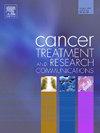接受降低风险药物治疗的已知乳腺癌风险妇女的症状负担
IF 2.4
Q3 Medicine
引用次数: 0
摘要
背景:美国约有1000万符合乳腺癌高危标准的女性,循证干预可能会将乳腺癌的风险降低50 - 65%。即使有大量证据支持预防性药物降低风险,但仍明显缺乏吸收和坚持。本研究的目的是描述乳腺癌高风险妇女的经历,并定义由乳腺癌风险和降低风险药物引起的症状负担的患者报告结果(PRO)测量的内容域。方法采用单次定性访谈法对30例接受降风险药物治疗的乳腺癌高危妇女进行调查。采用内容分析法确定症状负担。专家小组审查了定性访谈中确定的症状的相关性,以确定纳入PRO症状负担测量的项目。结果参与者平均年龄54.6岁;43.3%自认为是西班牙裔,20.0%自认为是黑人。内容分析发现20种症状与风险和预防性治疗均相关,其中8种症状报告的女性≥20%。所有妇女都描述了与她们的风险和预防性护理有关的痛苦。治疗相关症状因降低风险手术史和内分泌治疗类型而异。妇女描述了与症状相关的人际关系、工作、生活享受以及对降低风险药物的依从性的干扰。结论乳腺癌高危妇女在接受预防性护理的过程中存在独特的症状负担,包括多种症状和与症状相关的功能影响。本文章由计算机程序翻译,如有差异,请以英文原文为准。
The symptom burden of women with a known risk of breast cancer receiving risk reducing medication
Background
For the estimated 10 million women in the United States who meet the high-risk criteria for breast cancer, evidence-based interventions may reduce the risk of breast cancer by 50–65 %. Even with substantial evidence supporting preventive medication for risk reduction, there is significant lack of uptake and adherence. The purpose of this study was to characterize the experience of women at high risk for breast cancer and define the content domain for a patient-reported outcomes (PRO) measure of symptom burden from breast cancer risk and risk reducing medication.
Methods
Thirty women at high risk for breast cancer and receiving risk reducing medication participated in single qualitative interviews. Content analysis was used to identify the symptom burden. An expert panel review rated the relevance of symptoms identified in the qualitative interviews to establish the items for inclusion in a PRO symptom burden measure.
Results
Participants had a mean age of 54.6 years; 43.3 % self-identified as Hispanic and 20.0 % self-identified as Black. Content analysis found 20 symptoms related to both risk and preventive treatment, with 8 symptoms reported by ≥ 20 % of women. All women described distress related to their risk and preventive care. Treatment-related symptoms varied based on history of risk-reducing surgery and type of endocrine therapy. Women described symptom-related interference with relationships, work, enjoyment of life, and adherence to risk reducing medication.
Conclusions
Women with a known high risk of breast cancer and receiving preventive care experience a unique symptom burden including multiple symptoms and functional impact related to symptoms.
求助全文
通过发布文献求助,成功后即可免费获取论文全文。
去求助
来源期刊

Cancer treatment and research communications
Medicine-Oncology
CiteScore
4.30
自引率
0.00%
发文量
148
审稿时长
56 days
期刊介绍:
Cancer Treatment and Research Communications is an international peer-reviewed publication dedicated to providing comprehensive basic, translational, and clinical oncology research. The journal is devoted to articles on detection, diagnosis, prevention, policy, and treatment of cancer and provides a global forum for the nurturing and development of future generations of oncology scientists. Cancer Treatment and Research Communications publishes comprehensive reviews and original studies describing various aspects of basic through clinical research of all tumor types. The journal also accepts clinical studies in oncology, with an emphasis on prospective early phase clinical trials. Specific areas of interest include basic, translational, and clinical research and mechanistic approaches; cancer biology; molecular carcinogenesis; genetics and genomics; stem cell and developmental biology; immunology; molecular and cellular oncology; systems biology; drug sensitivity and resistance; gene and antisense therapy; pathology, markers, and prognostic indicators; chemoprevention strategies; multimodality therapy; cancer policy; and integration of various approaches. Our mission is to be the premier source of relevant information through promoting excellence in research and facilitating the timely translation of that science to health care and clinical practice.
 求助内容:
求助内容: 应助结果提醒方式:
应助结果提醒方式:


